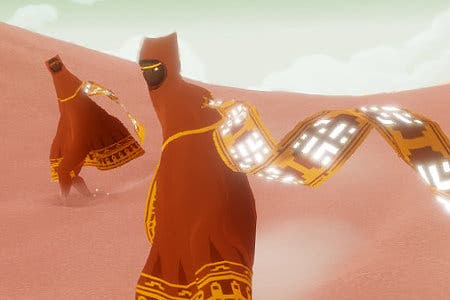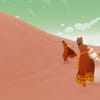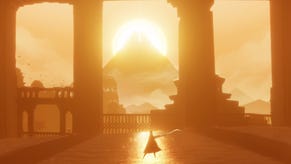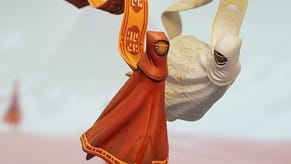Journey Review
Just deserts?
If Journey is about God, then God has played an awful lot of video games. One of the most fascinating things about thatgamecompany's sand-blown chunk of spiritual eye candy isn't that it reinvents gaming, or extends the medium's reach: it's that it takes old ideas - sometimes very old ideas - and repackages them in clever, stylish, and unexpected ways.
That glowing mountain on the horizon is a case in point. It seems like a straight lift from the Old Testament at first, but in Journey it's also your ultimate objective. It's both goal and waypoint marker, far less artificial than the breadcrumb trails of Perfect Dark Zero or Fable 2, but no less effective when it comes to the simple, crucial things that a game has to do - like keeping its players oriented as they move through large, artfully empty environments.
Or check out the scarf that billows and flaps around your devout and pin-legged avatar as you lean into the wind. It's part of a distinctive moth-brown uniform that comes teasingly close to referencing religious garb as varied as the burqa or a Franciscan's habit, but it's also there to tell you how much magical energy you have left for jumping and floating. It's a piece of standard UI, essentially, yet it's stuck right into the game world, tracing pretty little spirals in the desert air as form and function merge.
The more you explore, the more natural it all seems. Checkpoints become mysterious stone altars that you kneel before while saving your progress. The in-game economy, such as it is, comes in the shape of shreds of cloth that spin and tumble in the wind. Your climbing frames are made from ancient temples, smashed and broken in the dust, their finials and ornaments always a hair's breadth away from conforming to Middle-eastern, European, or Asian architectural styles. Daringly uncluttered maps fence you in with invisible walls that take the form of brutal winds or cascading rivulets of falling sand.
Journey's a fairly short adventure - if you're bringing such worldly concerns to this delicate piece of whimsy, you'll probably want to know that an initial play-through will clock in at about an hour and a half - but it makes a lot of pleasantly familiar stops along the way. The storyline leaves much to your own interpretation: you wake, alone, in the desert, and must then head towards a glowing peak in the distance. Everything beyond that is what you make of it. Yet the game's mechanics waste no time at all explaining exactly what you should be doing from one moment to the next.
This part's a little bridge puzzle. This glowing thing is an end-of-level marker. Over here you'll get to slide downhill for a while like you're playing SSX - see if you can aim for the gates, eh?
Journey has room for physics challenges, stealth sections, and even some gentle levelling up as you collect tokens that allow you to hover in the air for longer periods of time. But it does all of this with an unusual economy of control - you're basically limited to move, jump, float and, um, sing - and with a kind of sparse, widescreen, biblical imagination that redesigns classic gaming elements to the point that you'll barely recognise them.
The main beats of the narrative borrow much from thatgamecompany's previous game, Flower, but in terms of straight-up visual storytelling - when it comes to introducing mechanics wordlessly and prodding you through levels so that you always end up in exactly the right place - Journey's creators now seem the equal of Valve or even Nintendo. Infrequent prompts tell you how to press a button to float or how to rotate the pad to turn the camera (this is annoying, incidentally, and a real design imposition - thankfully you can also use the right thumbstick) but most of the guidance takes place without you even realising it.
Your viewpoint might shift gently as you head towards a tumbledown ruin so that you can pick an easy path onto its roof, while pools of light and murky shadows in the distance do much to draw you from one short chapter to another. There's room to explore as you make your way past rusting machinery, ancient gantries and desert canyons sparkling with tiny pieces of quartz - just as there's room, in such a sombre experience, to muck about a little and surf down the sides of dunes leaving large trenches in your wake. As the name suggests, though, this isn't really a game about hanging around. It's about moving on and making progress - as steadily, in fact, as if you were Link riding on Epona.
If Journey's in love with games, it's also quietly enamoured of cinema, too. Each hill you crest frames your next objective as a dreamy Technicolor spectacle, while there are distinct traces of Spielberg in particular in the lighting, the pacing, and the willingness to let a swooping, arching soundtrack dictate the mood. All of that is great, of course - nobody makes inhuman forces as warmly comforting as Spielberg - but Journey's picked up some of the director's weaknesses, too. This is elegant, masterful stuff, but it can actually seem a touch too polished on occasion. It's put together with such obvious skill that it can feel calculating - and even a little hollow.
That's how I felt on my first play-through, at least. Journey initially seemed to be an attempt to manufacture a kind of non-denominational religious experience for players: to make them feel like a small yet crucial part of something vast, mysterious and powerful. It's very hard to construct free-floating reverence, though, even if you're working with such a potent tool as a video game. You can design your way towards it, but you'll end up relying on shorthand: cathedral buttresses, shafts of light, planes shifting ominously beneath skies latticed by falling stars.
On my first trip through Journey, I was amazed at the craft and the scene-setting, and appreciative of the way that the storyline left careful gaps so as to allow for a handful of different interpretations, but the whole thing came off like a complex magic trick that didn't quite work. I felt admiration more often than awe. I was appreciative, but unmoved.
It turns out that I was missing a crucial piece of the experience, however. On my second play-through, I found it.
Two thirds of the way through Journey, the going gets tough. This isn't a hard game by any standards, but it's very good at creating a sense of hardship as you reach the final act. I was trudging along, wind-swept and battered, and I knew that things were only going to get worse. Then the clouds parted, just for a second. I turned a corner and caught a quick glimpse of a moth-brown shadow, clambering along in the distance.
It was another player. Journey does this: it sneakily shoves someone into your game from time to time, and then gives you the option to travel along with them. There's no voice chat available, and there are no naff combo moves to pull off in concert, but you can sing to them - this is essentially Journey's musical spin on a multi-purpose interact button - and you can often get basic points across in a kind of heavy-handed mime.
It sounds like rudimentary co-op, but it feels like nothing else. You're together, but separated. You meet, but you're always kept at arm's length, and you have no say in who you'll encounter.
So now I was able to work through Journey's darkest, most troublesome section with a companion. We pushed through the wind together, each singing one note, and then having the other echo it back. We recharged each other's jump power - a trick that normally only those scraps of floating cloth can do - and I guided my fellow traveller through some of the nastiest parts of the game: past traps and sudden winds and severe drops, onwards and upwards, until the mountain towered directly above us.
It was a total transformation. Play Journey with a random - and chances are that you will - and all the convenient metaphors and artificiality melt away. The game's lunges at profundity disappear, and you're left to focus on the core of the experience: a pilgrimage, filled with incident, compacted into the space of a few glorious set-pieces.
Granted, thatgamecompany's done most of the work for you. The studio has poured the deserts, trashed the temples and filled the world with the floating presence of a nameless almighty. The truly brilliant move, though, was to leave a space at the very centre of the design that only a stranger can fill.
The master stroke, as in all great myths, lies not with God, but with the human element.




















